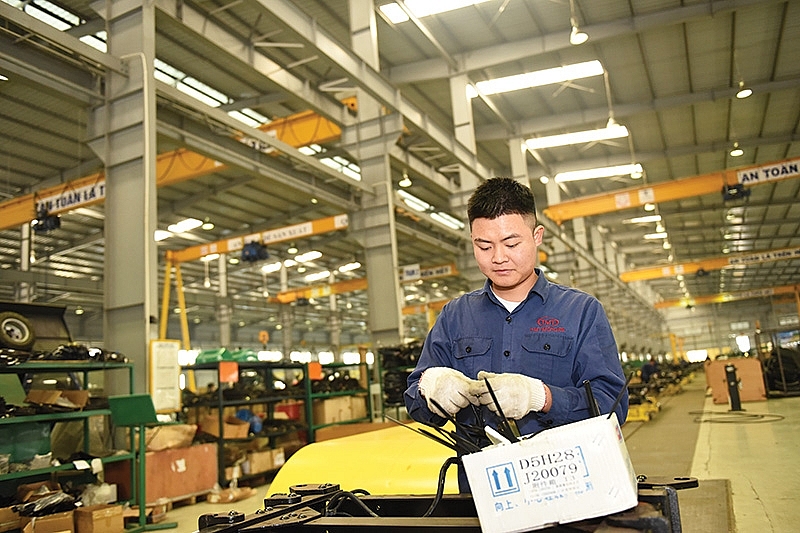Industry 4.0 strategy creation
 |
| Industry 4.0 strategy creation |
According to a joint survey conducted by the Ministry of Industry and Trade and the United Nations Development Programme in 2017 and 2018, Vietnamese industrial enterprises’ level of preparation for the Fourth Industrial Revolution (Industry 4.0) remains at a low level.
While the majority of companies are now at the starting point of a road to the digital-based approach of the future, in the list of 100 nations surveyed, Vietnam remains in a group that have yet to make sufficient preparations for the impending era of Industry 4.0.
These findings echo those of the Readiness for The Future of Production Report, released by the World Economic Forum in 2018. Vietnam’s ability to approach Industry 4.0 has been, and continues to be, hampered by a series of basic issues.
The first of these is the limited capacity for digitalising and connecting data within enterprises, among enterprises, and between enterprises and their partners. This has led to a very low rate of only 2 per cent of businesses that conduct self-operation and self-governance, featuring only 11-12 per cent in some sections of those businesses.
The second issue is that very few companies in Vietnam have access to smart products, which are those that are integrated with functions of IT and digital technology, offering services like localisation, self-reporting, and automatic self-identification. Smart products help companies to collect data from the use of their services and provide insight on how their customers shop, all of which can help boost sales of products and facilitate the development of new business services and models.
Similarly, only about 5 per cent of enterprises have models on data-based corporate governance. For example, the application rate of systems regarding supply chain management, product lifespan management, production planning system, and product data management is also low, at merely 2-3 per cent for all surveyed enterprises.
The final barrier is that the rate of industrial businesses that apply technologies, such as 3D printing, television wave-based identification, and Big Data related to Industry 4.0, is also at a very poor 2 per cent. The rate of those that utilise Artificial Intelligence and real-time location is about 3 per cent.
The survey also showed that 22 per cent of enterprises use data storing services, while merely 5 per cent employ data analysis services.
 |
| Businesses are being encouraged to focus on developing smart products and data collection to help understand customers on a deeper level, Photo: Dung Minh |
Seeking for solutions
Industry 4.0 has been creating immense challenges for companies to keep themselves afloat amid fierce competition. It forces them to quickly invent digital solutions in order to improve their competitiveness and capacity. In the short term, enterprises are advised to focus on many things for the upcoming era of Industry 4.0.
First, they need to create their own development strategy based on the foundations of Industry 4.0. This strategy must be new, flexible, and able to help businesses adapt to changes, as continual adaption is a huge part of successful businesses’ long-term development strategies.
Along with this, businesses need to start considering science and technology an integral part of their investment plans and utilise them to their full potential. Results from the survey have shown that up to 44 per cent of Vietnamese businesses fail to invest anything in science and technology.
Once their strategies have been developed, businesses need to invest in equipment-to-equipment connection. The critical disadvantage of many companies in Vietnam is that 70 per cent have equipment that cannot be controlled by IT or connected with other equipment types, while 75 per cent of businesses have no single digital technical model.
In addition, companies need to secure smart operation and service development based on data. In order to increase their readiness level, companies have been advised to boost their digital transformation processes and focus on developing smart products with a view to collecting information from sales and customer behaviour. This is also an important foundation for companies to develop data-based services.
In regards to workers, businesses need to prioritise more investment in training and the development of human skills suited to Industry 4.0. There is a necessity for many skills such as data analysis, software usage, and information security and technology. According to the survey, about 76 per cent of workers in businesses are yet to be trained in these skills.
It is becoming increasingly clear that Vietnamese companies cannot barricade against the inevitable tide of Industry 4.0. Instead, they should see it as a great opportunity for the renewal and modernisation of their operations and to improve their competitiveness in the market.
In practice, this is much easier said than done, as close to 97 per cent of Vietnamese businesses are small- and medium-sized and severely hindered in regards to available resources, especially to finance. The vast majority do not possess sufficient funds to invest in foreign-made digital transformation solutions worth millions of US dollars. Thus, domestic businesses in general cannot be expected to create major breakthroughs now.
Instead, the data transformation process and development of smart factories must be conducted step by step, with smart investment into new products and solutions provided by Vietnamese companies.
The new surge
In Industry 4.0, Vietnamese businesses have great opportunities for development thanks to the rapid advance in the global digital economy. These opportunities will go mainly to Vietnamese startups and small- to-medium- sized businesses.
Manufacturing businesses will also have opportunities to improve their production capacity and competitiveness via technological renovation, boosted application of digital technologies, and a gradual shift to a digital economy model.
A wave of Vietnamese startups is surging in the application of IT and digital technology, which was highlighted and praised last year at the Startup Funding Camp, a development programme held on a nationwide scale. This is down to startups’ use of data-based applications, epitomised by first prize winner bTaskee and its digital app focussing on time-based housework. The second prize was presented to TopCV, which hosts a platform for connecting job opportunities with digital application forms, while the third prize went to CyHome for its digitised system of tenement management and operation.
Industry 4.0 has created major challenges for the development of each nation and its enterprises, yet, challenges can transform into opportunities with appropriate and timely measures. The application of modern technology and an unwavering commitment to renovation and innovation will become decisive factors in the bid for Vietnamese enterprises to become successful in Industry 4.0. All of this will help to boost national development and international integration of such companies as well as Vietnam as a whole.
| Challenges for small- and medium-sized Vietnamese enterprises in their bid to integrate with global value chains A small number of Vietnamese enterprises have recently expanded their production regionally and globally. Last year, Vietnamese businesses invested around $430 million across 38 countries. However, this direct participation in global value chains is quite limited and does not lead to noticeable gains in productivity and efficiency. Indirect participation of small- and medium-sized enterprises (SMEs) with global value chains through their connections with foreign-invested enterprises (FIEs) is a more prevalent approach. Yet, only a handful of SMEs can participate in value-added stages of foreign direct investment-driven value chains. The potential benefits of productivity, innovation, and efficiency to SMEs are, therefore, not maximised. At least four constraining factors to SME connections with FIEs are capability, access to finance, policy co-ordination, and regulatory framework. Source: The Asian Development Bank |
What the stars mean:
★ Poor ★ ★ Promising ★★★ Good ★★★★ Very good ★★★★★ Exceptional
Themes: Unleashing The Private Sector
Related Contents
Latest News
More News
- Main drivers for Vietnam’s digital economy future (December 03, 2025 | 11:35)
- Pivotal stage of growth paves way for rise in M&As (December 03, 2025 | 10:00)
- Positive projections for M&A interest from Thailand (December 03, 2025 | 09:40)
- Manifesting the first line of defence in cybersecurity (December 03, 2025 | 09:00)
- The transformational role AI can play in accounting arena (December 03, 2025 | 08:00)
- Unlocking 5G-AI potential in Singapore (December 03, 2025 | 08:00)
- Data-driven strategies vital for a fast-evolving nation (December 02, 2025 | 09:41)
- Policy to practice: how Vietnam can lead the region (November 26, 2025 | 16:03)
- Mobilising private capital at scale vital for climate battle (November 26, 2025 | 15:36)
- VILAF and Yoon & Yang launch Vietnam - Korea Practice Unit (November 26, 2025 | 15:16)

 Tag:
Tag:





















 Mobile Version
Mobile Version